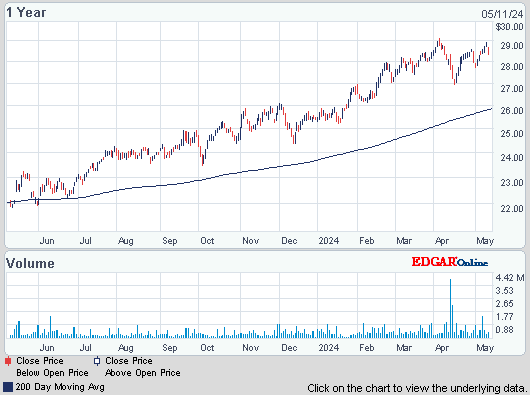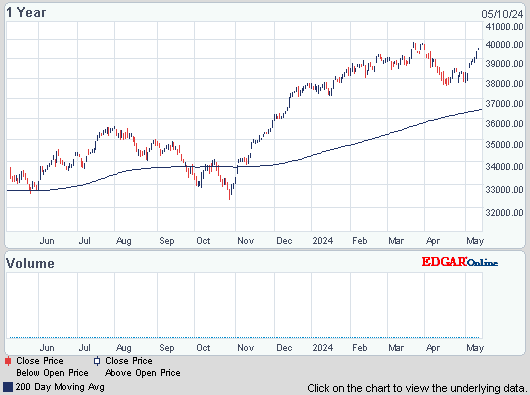Dow gained 207 (closing at the highs), advancers oevr decliners a more moderate 2-1 & NAZ went up 45. The MLP index shot up 6 to 449 (a whopping 13 in 2 days) while the REIT slipped a fraction to the 284s. Junk bond funds were mixed to lower & Treasuries sank while stocks rallied. Oil rallied with stocks & rose while gold tumbled the most in 7 weeks after employment
in the US increased more than forecast in May, boosting concern that
the Federal Reserve (FED) may scale back monetary stimulus.
AMJ (Alerian MLP Index tracking fund)

![Live 24 hours gold chart [Kitco Inc.]](http://www.kitco.com/images/live/gold.gif)

Occupations paying below-average wages accounted for more than half of last month’s payroll increase, a dynamic that may restrain consumer spending & the economic recovery. Retailers, the hospitality industry & temporary-help agencies accounted for 96K, or 55%, of 175K jobs added in May. The composition of the employment gain caused hourly earnings for all employees to stagnate at $23.89 on average last month, up a penny from Apr & they rose 2% over the past 12 months, compared with year-to-year increases averaging 3.5% in the 10 months leading up to the recession. The leisure & hospitality industry, which includes hotels, restaurants, casinos & amusement parks, added 43K. On average, those employees are paid $13.45 an hour, the lowest of any of the 10 major employment categories, according to the Labor Dept. Retailers added 28K jobs in May, with an average hourly wage of $16.63. Temporary help accounted for 26K jobs with an average wage of $15.74 an hour. Other lower-paying occupations, including ambulatory & home health care services, also posted gains last month. In contrast, construction companies, which pay employees an average $26.06 an hour, added 7K jobs in May & manufacturing, which pays $24.22 an hour, lost 8K jobs. There were 7.9M working part-time in May for economic reasons, meaning they preferred full-time work but couldn’t get it, according to Labor Dept data. While down from the record 9.2M reached in Sep 2010, it’s up from the 4.4M on average during the previous expansion.
Bulk of U.S. Payroll Gain in Jobs Paying Less-Than-Average Wages
Consumer credit in the US accelerated in Apr as Americans took out more education & automobile loans. The $11B increase in credit followed a revised $8.4B increase the previous month that was more than initially reported, FED figures showed. The forecast called for a $12.9B gain in Apr. Higher stock and property values are putting households in a position to take advantage of low interest rates for bigger purchases, such as cars. Credit-card use also rose as Americans contended with higher payroll taxes & limited income growth. Non-revolving debt, such as that for college tuition & the purchase of vehicles and mobile homes, increased $10.4B, today’s report showed. Revolving debt, which includes credit cards, increased by $682M after a $906M decrease. Personal spending in Apr fell 0.2% after a 0.1% gain in the prior month, according to the Commerce Dept. Incomes were unchanged following a 0.3% advance.
Consumer Credit in U.S. Climbed in April on Non-Revolving Loans

Photo: Bloomberg
Apple is starting an iPhone trade-in program this month aimed at getting users to upgrade to the iPhone 5 & turn in older models as it teamed up with Brightstar (STAR), a mobile-phone distributor, to run the exchange program. By offering money for older smartphones, AAPL CEO Tim Cook is seeking to entice consumers to upgrade to the latest models, part of the company’s efforts to reignite sales growth & combat declining shares. Since AT&T (T) is currently paying as much as $200 for working iPhone 4s & 4Ss, some customers could buy an entry-level iPhone 5 for no money down. Until now, AAPL paid little attention to the refurbished iPhone market. That’s changing as its growth has slowed in recent qtrs. 37M units of the iPhone were sold in the latest qtr, compared with 35M a year earlier. The stock rose 3 to over 441 but has a dreary chart in the last year..
Apple Said to Plan Trade-Ins of Old IPhones for First Time to Boost Sales

Stocks closed the week on a winning note. With today's rally, the Dow was up more than 100 this week & is within 200 of its recent record high. Another way to think about the Dow is that it's returned to where it was in mid May. The MLP index rose modestly in Jun while the REIT index continues under selling pressure & junk bond funds are struggling to find buyers. The search for higher yields was largely limited to MLPs this week. I still don't like this market because this week is a vivid reminder that it is relying on the FED to keep rates low. When that change comes, the markets will sell off, as they did this week on just hints of that.
Dow Jones Industrials

AMJ (Alerian MLP Index tracking fund)
Treasury yields:
U.S. 3-month |
0.04% | |
U.S. 2-year |
0.30% | |
U.S. 10-year |
2.16% |
| CLN13.NYM | ...Crude Oil Jul 13 | ...96.09 | (1.4%) |
| GCN13.CMX | ...Gold Jul 13 | .....1,381.70 | (2.4%) |
![Live 24 hours gold chart [Kitco Inc.]](http://www.kitco.com/images/live/gold.gif)

Occupations paying below-average wages accounted for more than half of last month’s payroll increase, a dynamic that may restrain consumer spending & the economic recovery. Retailers, the hospitality industry & temporary-help agencies accounted for 96K, or 55%, of 175K jobs added in May. The composition of the employment gain caused hourly earnings for all employees to stagnate at $23.89 on average last month, up a penny from Apr & they rose 2% over the past 12 months, compared with year-to-year increases averaging 3.5% in the 10 months leading up to the recession. The leisure & hospitality industry, which includes hotels, restaurants, casinos & amusement parks, added 43K. On average, those employees are paid $13.45 an hour, the lowest of any of the 10 major employment categories, according to the Labor Dept. Retailers added 28K jobs in May, with an average hourly wage of $16.63. Temporary help accounted for 26K jobs with an average wage of $15.74 an hour. Other lower-paying occupations, including ambulatory & home health care services, also posted gains last month. In contrast, construction companies, which pay employees an average $26.06 an hour, added 7K jobs in May & manufacturing, which pays $24.22 an hour, lost 8K jobs. There were 7.9M working part-time in May for economic reasons, meaning they preferred full-time work but couldn’t get it, according to Labor Dept data. While down from the record 9.2M reached in Sep 2010, it’s up from the 4.4M on average during the previous expansion.
Bulk of U.S. Payroll Gain in Jobs Paying Less-Than-Average Wages
Consumer credit in the US accelerated in Apr as Americans took out more education & automobile loans. The $11B increase in credit followed a revised $8.4B increase the previous month that was more than initially reported, FED figures showed. The forecast called for a $12.9B gain in Apr. Higher stock and property values are putting households in a position to take advantage of low interest rates for bigger purchases, such as cars. Credit-card use also rose as Americans contended with higher payroll taxes & limited income growth. Non-revolving debt, such as that for college tuition & the purchase of vehicles and mobile homes, increased $10.4B, today’s report showed. Revolving debt, which includes credit cards, increased by $682M after a $906M decrease. Personal spending in Apr fell 0.2% after a 0.1% gain in the prior month, according to the Commerce Dept. Incomes were unchanged following a 0.3% advance.
Consumer Credit in U.S. Climbed in April on Non-Revolving Loans

Photo: Bloomberg
Apple is starting an iPhone trade-in program this month aimed at getting users to upgrade to the iPhone 5 & turn in older models as it teamed up with Brightstar (STAR), a mobile-phone distributor, to run the exchange program. By offering money for older smartphones, AAPL CEO Tim Cook is seeking to entice consumers to upgrade to the latest models, part of the company’s efforts to reignite sales growth & combat declining shares. Since AT&T (T) is currently paying as much as $200 for working iPhone 4s & 4Ss, some customers could buy an entry-level iPhone 5 for no money down. Until now, AAPL paid little attention to the refurbished iPhone market. That’s changing as its growth has slowed in recent qtrs. 37M units of the iPhone were sold in the latest qtr, compared with 35M a year earlier. The stock rose 3 to over 441 but has a dreary chart in the last year..
Apple Said to Plan Trade-Ins of Old IPhones for First Time to Boost Sales
Apple (AAPL)
Stocks closed the week on a winning note. With today's rally, the Dow was up more than 100 this week & is within 200 of its recent record high. Another way to think about the Dow is that it's returned to where it was in mid May. The MLP index rose modestly in Jun while the REIT index continues under selling pressure & junk bond funds are struggling to find buyers. The search for higher yields was largely limited to MLPs this week. I still don't like this market because this week is a vivid reminder that it is relying on the FED to keep rates low. When that change comes, the markets will sell off, as they did this week on just hints of that.
Dow Jones Industrials











No comments:
Post a Comment